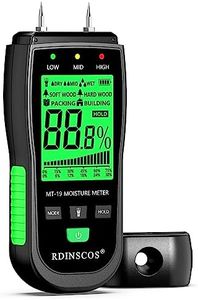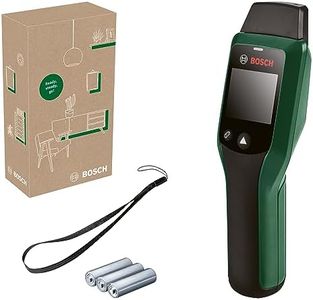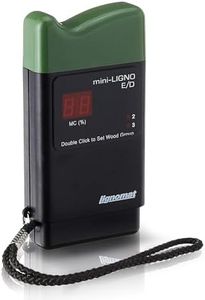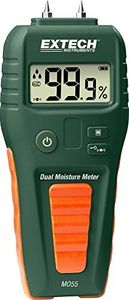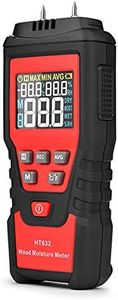We Use CookiesWe use cookies to enhance the security, performance,
functionality and for analytical and promotional activities. By continuing to browse this site you
are agreeing to our privacy policy
10 Best Wood Moisture Meters
From leading brands and best sellers available on the web.Buying Guide for the Best Wood Moisture Meters
Choosing a wood moisture meter is important if you work with wood for construction, woodworking, or flooring. The right meter helps you measure the water content in wood, which can affect strength, stability, and appearance. Picking the right model ensures more accurate results for your projects and prevents problems like warping, cracking, or mold.Pin vs. PinlessThere are two main types of wood moisture meters: pin and pinless. Pin meters use small metal probes that you push into the wood, measuring moisture between the pins. These tend to be more affordable and precise for specific spots, but they can leave tiny holes on the surface. Pinless meters use sensors that rest on the wood’s surface, measuring moisture to a certain depth without damaging the wood. If you care about surface appearance or need faster scanning, pinless is convenient. If you want deeper or highly accurate readings at specific depths, pins are often a better choice. Pick based on whether surface appearance or precision at depth is more important for your use.
Measurement RangeThe measurement range tells you the lowest and highest percentage of moisture content the meter can read in the wood. Most wood applications need meters that can read from about 5% (very dry) up to 30% (very wet). If you’re working with kiln-dried or indoor wood, a low end of the range is important for accuracy with dry wood. For construction or outdoor wood, a wider and higher range may help. Choose a range that covers the typical moisture levels you'll encounter.
AccuracyAccuracy is about how close the meter’s results are to the wood’s actual moisture content. Measured as +/- percentage, lower numbers mean more reliable readings. For fine woodworking or critical building projects, higher accuracy (like within 1-2%) is best. General DIY or quick checks can make do with slightly less precision. Think about how crucial exact results are for your tasks: higher accuracy is better if mistakes are costly or unsafe.
Depth of MeasurementDepth of measurement tells you how far into the wood the meter can sense moisture. Some meters, especially pinless, let you specify depth; others have a fixed depth. Shallow depth is good for surface checks, while deeper measurements help spot moisture inside thick boards or beams. If you deal with thick woods or want to spot hidden moisture, a deeper option is important. For simple surface work, shallow depth may be all you need.
Species CorrectionDifferent types of wood conduct electricity or absorb moisture differently. Many meters let you adjust settings for different wood species. This feature makes readings more reliable, especially if you use a wide variety of woods. If you mostly use one local species, this is less critical, but for professionals or hobbyists working with many kinds, built-in or manual species correction is very helpful.
Display and ReadabilityThe display is how you read your results. Clear, large, and backlit displays are easier to use in workshops or dim conditions. Some meters have digital screens, while basic models might use analog needles. If you want quick, clear, and unambiguous readings or need to use the meter in dark places, look for a bright and simple digital display.
Durability and Build QualityWoodworking environments can be rough. A moisture meter should be sturdy and able to handle drops, dust, or being tossed in a toolbox. Durable, weather-resistant materials and protective cases are helpful if you use the meter often or outdoors. Think about where you’ll use it—occasional indoor use might not require as much toughness as heavy site work.
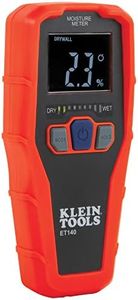
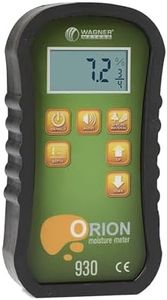
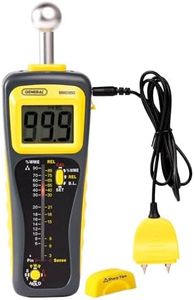
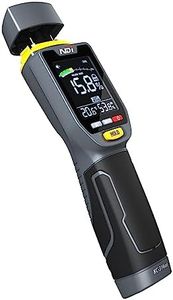

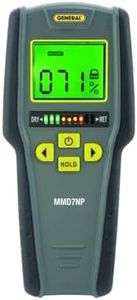
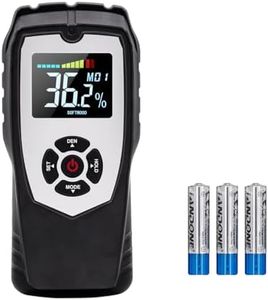
![[Pinless Wood Moisture Meter] Dr.meter Upgraded Version Inductive Pinless Tools Intelligent Moisture Meter Digital Moisture Meter for Wood (Range 4% - 80% RH; Accuracy: 0.5%) MD918](https://images-proxy.bestreviews.guide/9_bJBe9VDUQFHETnDosVM6CCWaE=/0x300/https://m.media-amazon.com/images/I/41I8dsrtwjL._AC_CX679_.jpg)
